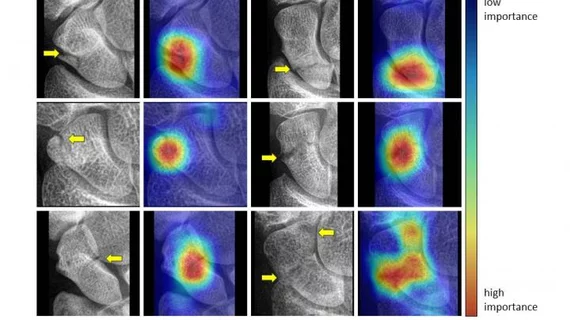Automated tool can help radiologists avoid overlooking wrist fractures on X-ray exams
An artificial intelligence-driven system can help radiologists detect a common type of wrist fracture that is easily overlooked during initial X-ray exams.
Scaphoid fractures typically arise when people try to break a fall with their hands, composing up to 7% of all skeletal fractures, researchers explained Wednesday in Radiology: Artificial Intelligence. And while timely diagnosis is key to recovery, conventional X-ray is limited by overlap with surrounding bones, wrist positioning and other factors.
With the help of thousands of wrist scans, the group developed an automated technique that can detect underlying patterns in these X-rays indiscernible to human eyes.
"The system may be able to assist residents, radiologists or other physicians by acting either as a first or second reader, or as a triage tool that helps prioritize worklists, potentially reducing the risk of missing a fracture," lead author Nils Hendrix, PhD, with Jeroen Bosch Hospital’s Department of Radiology in the Netherlands, said April 28.
Prior efforts have shown convolutional neural networks fall short at identifying scaphoid fractures compared to humans. But Hendrix and co-investigators utilized more advanced algorithms and larger datasets for their research.
The tool was tested on a set of 190 X-rays and put up against 11 radiologists’ interpretations.
Overall, the AI performed similarly to imaging experts. It was able to achieve a sensitivity of 78% for spotting fractures and a positive predictive value of 83%.
Hendrix believes using this automated tool as an assistant could prevent delays in therapy, reduce complications and the costs of additional imaging exams.
Looking ahead, the plan is to extend their scaphoid detection system to combine with multiple X-ray views for enhanced predictions. The Dutch team is also performing a study in which radiologists identify fractures with and without AI assistance.
They ultimately hope to expand the tool beyond fractures to other bone structures.

